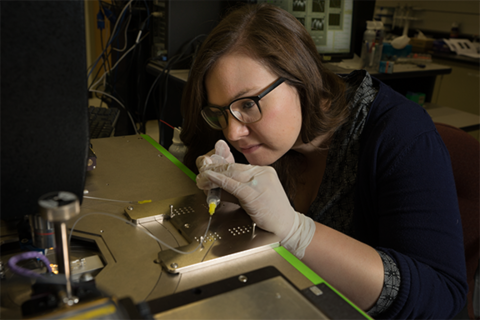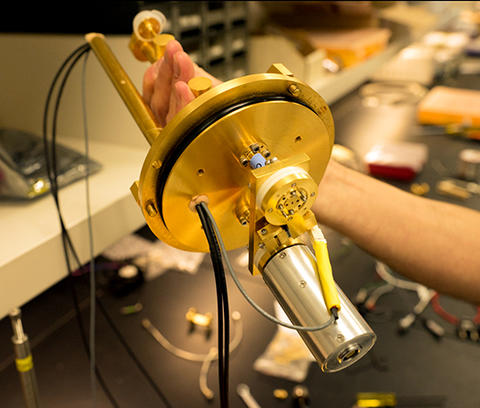Guided Wave Electromagnetics Group
The Guided Wave Electromagnetics Group conducts theoretical and experimental research to develop basic metrology, special measurement techniques, and measurement standards necessary for advancing both conventional and microcircuit guided-wave technologies; characterizing active and passive devices and networks; and for providing measurement services for scattering parameters, power, waveform, noise, material properties, and other basic quantities

OVERVIEW
The Guided Wave Electromagnetics Group provides fundamental electromagnetics research, including measurements, modeling, and theory, to support advanced wireless communications and other key national priorities in electromagnetics at RF, microwave, and mm-wave frequencies. Research is focused on traceable measurements of fundamental microwave quantities such as power and impedance; advanced guided-wave measurements and standards for integrated-circuit environments; fundamental material properties and modeling at RF, microwave, and mm-wave frequencies; and metrology for nonlinear microwave systems, devices, and materials. The development of efficient strategies for the dissemination of fundamental measurement quantities, including measurement data, analysis approaches, and modeling, is also a key focus of the group.
MAJOR ACTIVITIES
Traceable Microwave Power
Traceable measurements of microwave power are critical for the development and deployment of new and existing wireless communications systems. Microwave power is a fundamental quantity, and traceable measurements with uncertainties provide a solid basis for many different types of measurements relevant for wireless communications, particularly for modulated signal measurements, accurate evaluation of systems, components, and devices, as well as material characterization. Work in this area involves the development and evaluation of traceable primary standards for microwave power, as well as transfer standards and measurement services for the dissemination of traceable power to the microwave and communications communities.
Traceable Impedance
Fundamental metrology in communications requires the ability to unambiguously determine the impedance of a reference environment and to provide linear transformations of measurements to measurement reference planes of interest. This is accomplished for multiple conducted systems through a series of physical standards, which are used to determine a 50 ohm reference impedance, with rigorous uncertainty analysis, and disseminated through a quality-managed comparative measurement process. Traceable impedance metrology is also applied to the development of traceable nonlinear measurements for wireless communications.
On-Chip Materials
All telecommunications components—transistors, amplifiers, mixers, etc.—are made from materials. Knowing the material properties, whether they are electrical, mechanical, or thermal is essential to predicting how a device will perform. If one can predict how a device will perform, one can build larger more complex integrated telecommunications components.

Finite-element and multi-physics simulations are ubiquitous in the design and development of devices for current and future generation wireless communications, such as integrated multi-band filters, switches, interconnects, duplexers, circulators, etc. The accuracy of models for wireless communications components depends primarily on the accuracy of the input material parameters, which can be difficult to evaluate over a broad range of frequencies, particularly for materials that display inhomogeneous, anisotropic, and/or nonlinear properties. Metrology focused on the accurate evaluation of microwave material properties beyond the linear, isotropic, and homogeneous limits will enable new approaches in microwave component design for interference mitigation, higher energy efficiency, higher spectral efficiency, and higher levels of integration in wireless communications. This is accomplished primarily through the detailed comparisons of computational models with accurate, broadband measurements of custom-fabricated planar test structures.
Advanced IC Metrology
To perform as intended, modern electronics—transistors, amplifiers, mixers, etc.—must simultaneously control large-amplitude electrical signals at up to ten harmonics (i.e., multiples) of the operating frequency. Engineering this control requires test equipment to generate larger-amplitude diagnostic signals with precisely known and controlled magnitudes and phases at these harmonics. As part of the Innovations in Measurement Science program, we are building a DC to 1 THz large-amplitude optoelectronic multitone electrical-signal synthesizer. The key ideas are to combine the large amplitudes of new electronic amplifiers with the THz bandwidth of optics, and divide frequencies down to reduce noise. This work goes beyond providing new tools for NIST to explore new materials and fundamental physics by facilitating large-amplitude tests on modern electronics operating above 40 GHz. These tests accelerate the introduction of the high-bandwidth, low-latency telecommunications systems needed to ensure US leadership in autonomous infrastructure, exascale computing, and augmented reality.
Publications
Awards
Contacts
Group Leader
-
(303) 497-7900

